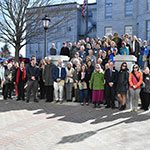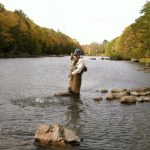December 2019
Maine Public has a great look at the news that Hydro-Quebec has launched a PAC to spend big in support of its money-making CMP corridor project.
Though CMP and HQ aim to spend huge sums to try and convince Mainers their destructive project is a good thing, they can’t erase the fact that vast majorities of Maine people oppose it. Wildlife biologist Ron Joseph outlined his reasons for opposing the project in a recent op-ed.
Brunswick area legislators wrote an op-ed highlighting how the state continues to lead on climate action. And both of Maine’s U.S. Senators signed onto a letter calling for ambitious action on climate from the federal government.
We were excited to read that Land for Maine’s Future funding will support the possible purchase of the last remaining greenspace in Greenville along the Moosehead Lake shoreline.
News Center Maine takes a look at how Bangor is preparing for its ban on foam food containers, which goes into effect a year ahead of Maine’s, and a UMaine Fellow urges us to confront all of the trash that’s created during the holidays.
We found this op-ed on what makes activism effective very insightful, with some great takeaways for our continued work with communities across Maine to protect the environment!
The US Army Corps of Engineers held what could be the last public meeting on the trouble CMP corridor proposal, and boy did Mainers show up! Nearly 300 packed the room, the vast majority of whom were opposed to this disastrous project. The hearing and a press conference NRCM held were covered extensively by the media, including Maine Public, WGME, WMTW, and News Center Maine.
Days later, CMP’s PAC was forced to pull the names of several environmental groups it had been claiming support the project and its parent company was fined for issues stemming from poor management at CMP.
That Canadian Hydro Comes at a Cost
The Pulitzer Center and Maine Public partnered on an in-depth, multi-story series about the cultural and environmental impacts of large-scale hydro. And Canadian tribal members recently toured through Maine to highlight these impacts on native people in Canada.
Gov Mills Steps Up State Climate Action
At a ribbon cutting ceremony for new solar panels at the Blaine House, Governor Mills announced that state agencies will step up their efforts to combat climate change and WGME took a look at the bright future for solar in Maine!
Actions like this, including Attorney General Aaron Frey’s involvement in a lawsuit on tailpipe emissions and UMaine’s floating offshore wind project, are all the more important given a recent UN report that called for accelerated carbon reductions to meet targets set by nations across the world. Thankfully, Congresswoman Pingree joined her colleagues recently in filing a bill to transition to a 100% clean economy.
Indigenous Canadians Highlight Damage of Large Hydro
Indigenous Canadians toured Maine this week to highlight the damage that large hydro projects have done to their homeland and culture.
Farther south, the Yale student newspaper ran a long feature on the CMP corridor and push back from Yale community members about the University’s involvement in the troubled project.
Concerns About Rockweed Harvesting
The Boston Globe highlighted the clash on the coast over commercial rockweed harvesting, an issue that was raised in the last legislative session and is sure to come up again.
EV Trash Trucks?
ecomaine is featured in this national story about waste haulers beginning to look at electric garbage trucks.
November 2019
Hits Keep Coming for CMP
In another brutal hit to CMP’s reputation and a reflection of how deep the company’s inability to deliver for customers is, a new national survey of business satisfaction with utilities ranked CMP dead last in the nation. Maybe if they stopped spending so much time and money on their troubled corridor project the company could fix some of its longstanding customer service issues?
The Bangor Daily News political team looked at how CMP’s horrible reputation will impact the potential referendum campaign against the CMP corridor.
Dunkin Ditching Foam
Dunkin Donuts announced it’s going to phase out the use of foam coffee cups, in part because of Maine’s new ban on foam food containers. Unfortunately, the company admits its new paper coffee cups may not be recyclable and passed the buck to local cities and towns. This is a perfect example of why the recycling reform that our Sustainable Maine team is working on is so important – it’ll incentive companies to produce and use products that are easily recyclable so towns aren’t stuck with the cost of cleaning up wasteful stuff!
Recycling Beer Can Holders
A new collaboration led by some of the state’s breweries aims to give people the opportunity to recycle plastic beer can holders by dropping them off at their breweries. Unfortunately, the holders can’t be recycled at home so this new program is filling the gap.
Extreme Weather Changes
The Bangor Daily News published an excellent explainer of how climate change is contributing to extreme weather events in Maine.
DEP Commissioner on Maine Calling
Maine’s Department of Environmental Protection Commissioner Jerry Reid joined Maine Calling for a discussion of his department’s priorities. Listen in for a special appearance by NRCM’s Sarah Nichols!
In Corridor news, CMP corridor opposition forces quickly collected more than 25,000 signatures since launching the ballot referendum initiative:
Opponents of Central Maine Power’s proposed transmission line project through western Maine say the effort to put the issue on the 2020 ballot got a boost from Tuesday’s election. The group “No CMP Corridor” says it has collected more than 25,000 signatures after deploying volunteers to polling places around the state. The group needs to submit more than 60,000 valid signatures to the Secretary of State by February 3 in order to qualify for the 2020 ballot. Read more.
Election Day turnout light in central Maine, though some motivated by CMP petition
Even before the light rain started to fall midday, voter turnout at the polls across central Maine was light Tuesday, although clerks said voters were casting ballots in a steady stream and several people said they were motivated to sign a petition calling for a statewide referendum on the controversial Central Maine Power corridor proposal.
Residents of Woolwich made their feelings about the CMP proposal clear by revoking their initial support for the project: Voters Tuesday revoked the town’s support of Central Maine Power’s proposed 145-mile transmission line that would send hydropower from Canada to Massachusetts. According to unofficial election results, 585 people voted in opposition to the proposed corridor, and 176 voted in favor. On a second referendum question Tuesday, residents voted 611-158 to have the select board withdraw a 2017 letter selectmen had written in support of the project. Now, board members will draft a new letter opposing the corridor push.
We were delighted to see that our new neighbor, Governor Janet Mills, erected solar panels at the Blaine House this week:
The installation of solar panels at the governor’s mansion in Augusta got underway Tuesday, fulfilling a vow by Gov. Janet Mills to lead by example in the state’s effort to dramatically reduce carbon emissions by 2050. Workers from ReVision Energy read measurements as they construct a large solar tracker, which follows the sun across the sky, on the front lawn of the mansion grounds. And nearby on the garage, a two-man crew installed mounts for rooftop panels. There are no panels on the roof of the Blaine House, which is a national historic landmark. Mills’ office says the project costs $63,000 and will reduce the mansion’s electricity bill — roughly $11,000 last year — by about 25 percent in the first year.
October 2019
The Portland City Council voted on Monday night to ban the sale and distribution of plastic drinking straws, becoming the first Maine city to do so in an attempt to reduce the amount of plastic-based pollution clogging the world’s oceans and landfills. Starting April 1, 2020, patrons at bars, restaurants, and other straw-serving establishments will have to ask for a straw to be provided with one. The outright ban on the distribution of straws begins Jan. 1, 2021. The two-phase approach is designed to give residents and businesses time to adjust to the change. The measure passed 8-0, with Councilor Pious Ali absent. Portland joins at least eight cities in California, including San Francisco, along with other major U.S. municipalities such as Seattle and Miami in banning straws. The ordinance also includes single-use stirrers and splash sticks. Read the full story.
U.S. Rep. Jared Golden is concerned about what he calls a “lack of transparency” in the U.S. Army Corps of Engineers’ review and permitting process for Central Maine Power’s controversial 145-mile transmission corridor through western Maine. NRCM’s clean energy attorney Sue Ely provided comment and applauded Golden for “standing up for Maine’s right to participate in federal permitting decisions.” She added, “The proposed CMP corridor is a massive project that has generated enormous public interest. It deserves a public hearing, and we are thankful that Congressman Golden has requested one,” Ely said Wednesday. Read the full story.
Maine this fall is in the midst of a land rush, not for gold but for sunshine. A recent law encouraging large solar projects, combined with the aggressive clean-energy goals of Gov. Janet Mills, have energy companies and developers from across the country trying to lock down prime sites for dozens of multi-million dollar community solar farms. The most appealing sites are on flat ground, with a southern exposure near high-voltage power lines and substations. What’s driving the activity now is a major rewrite of community solar rules by the last Legislature, which removed random, restrictive limits that, for instance, limited membership to fewer than 10 customers. Suddenly, Maine is on the radar of the national solar industry. It’s joining other states like Massachusetts, which has had policies encouraging community solar since 2008. Read the full story.











